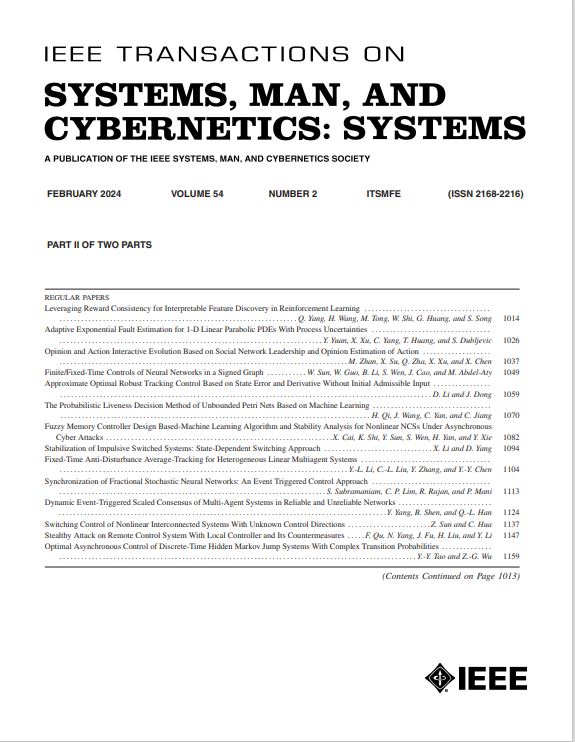Robust Adaptive Sliding Mode Security Control of Markov Jump Cyber-Physical Systems With Stochastic Injection Attacks Through Event-Triggered-Based Observer Approach
IF 8.6
1区 计算机科学
Q1 AUTOMATION & CONTROL SYSTEMS
IEEE Transactions on Systems Man Cybernetics-Systems
Pub Date : 2025-03-13
DOI:10.1109/TSMC.2025.3547020
引用次数: 0
Abstract
This article addresses the challenge of state observer design for sliding mode security control in Markov jump cyber-physical systems subjected to stochastic injection attacks. To enhance network efficiency, a dynamic event-triggered algorithm is introduced in the communication channel. First, the design begins with a Luenberger state observer featuring an adaptive compensator. This configuration aims to effectively counteract malicious attacks. Second, an integral sliding hyperplane is formulated within the estimation space, which serves as the foundation for deriving the sliding mode dynamics, ensuring robustness against disturbances. Recognizing the diversity of transition rates (TRs), an elastic sliding mode controller is designed to accommodate three distinct types of TRs, which is also strategically designed to guarantee reachability and maintain sliding motion. Third, stochastic stability with an通过基于事件触发的观测器方法,实现具有随机注入攻击的马尔可夫跃迁网络物理系统的鲁棒自适应滑模安全控制
研究了马尔可夫跳变网络物理系统在随机注入攻击下滑模安全控制的状态观测器设计问题。为了提高网络效率,在通信信道中引入了动态事件触发算法。首先,从具有自适应补偿器的Luenberger状态观测器开始设计。该配置的目的是为了有效抵御恶意攻击。其次,在估计空间内构造了一个积分滑动超平面,作为滑模动力学推导的基础,保证了对扰动的鲁棒性;考虑到过渡速率(TRs)的多样性,设计了一种弹性滑模控制器来适应三种不同类型的TRs,并在策略上设计以保证可达性和保持滑动运动。第三,对每种类型的TR分别进行了$H_{\infty }$衰减水平的随机稳定。相应的,提出了在触发条件下确定阈值参数的算法。同时,给出了芝诺行为不存在的证明,保证了系统的稳定性和效率。最后,通过一个实际模型的仿真研究,实证地证明了该方法在现实环境中的有效性。
本文章由计算机程序翻译,如有差异,请以英文原文为准。
求助全文
约1分钟内获得全文
求助全文
来源期刊

IEEE Transactions on Systems Man Cybernetics-Systems
AUTOMATION & CONTROL SYSTEMS-COMPUTER SCIENCE, CYBERNETICS
CiteScore
18.50
自引率
11.50%
发文量
812
审稿时长
6 months
期刊介绍:
The IEEE Transactions on Systems, Man, and Cybernetics: Systems encompasses the fields of systems engineering, covering issue formulation, analysis, and modeling throughout the systems engineering lifecycle phases. It addresses decision-making, issue interpretation, systems management, processes, and various methods such as optimization, modeling, and simulation in the development and deployment of large systems.
 求助内容:
求助内容: 应助结果提醒方式:
应助结果提醒方式:


